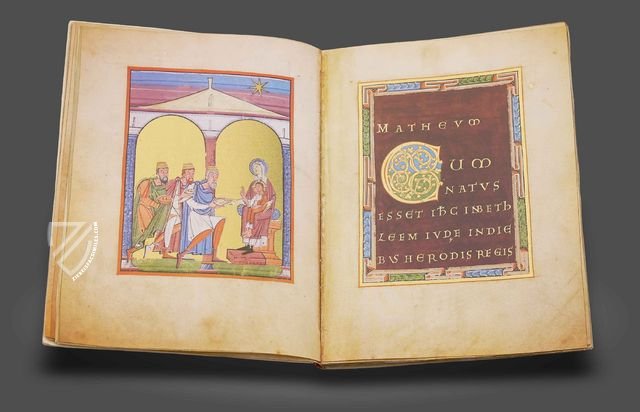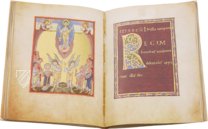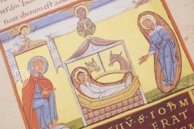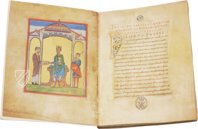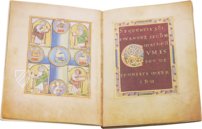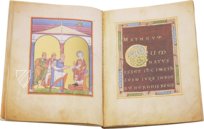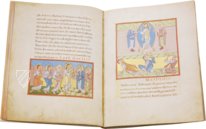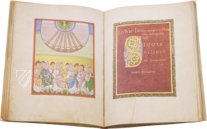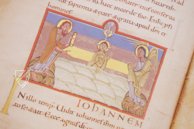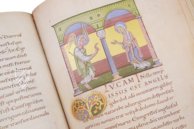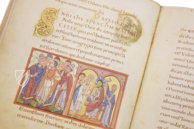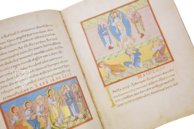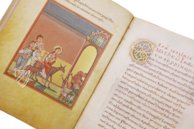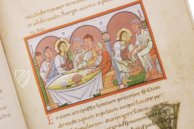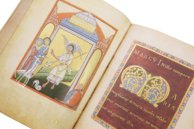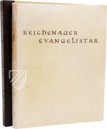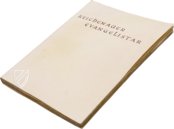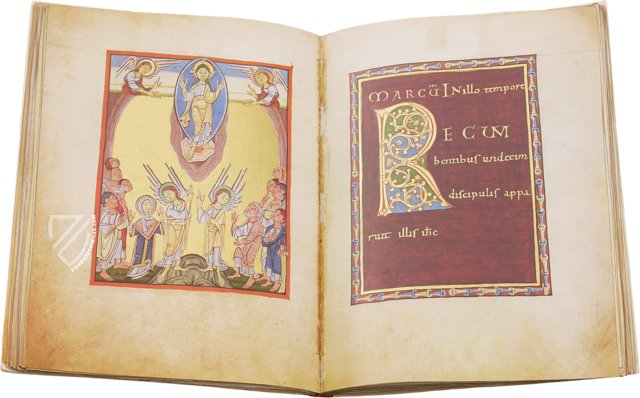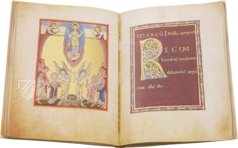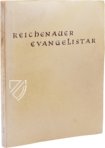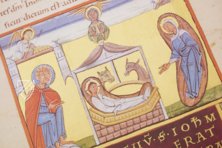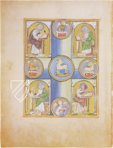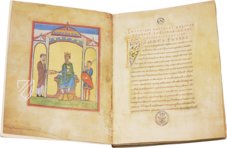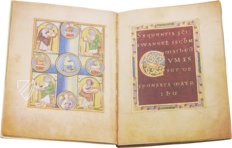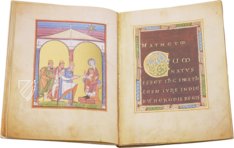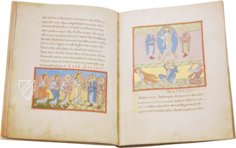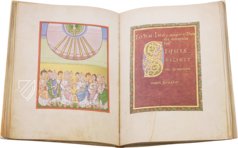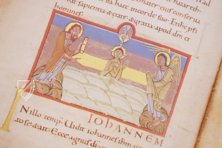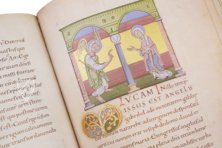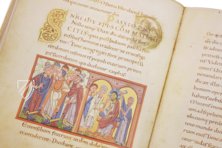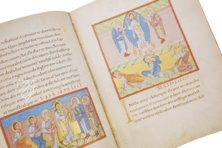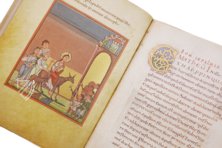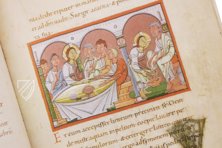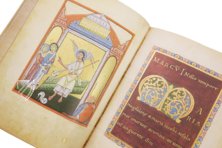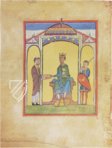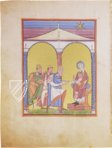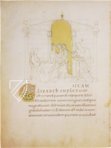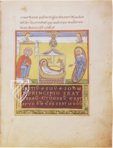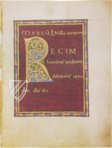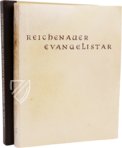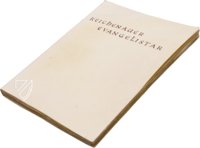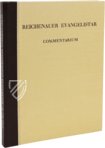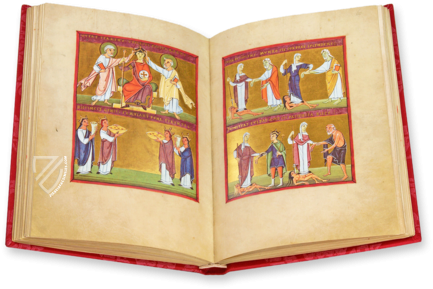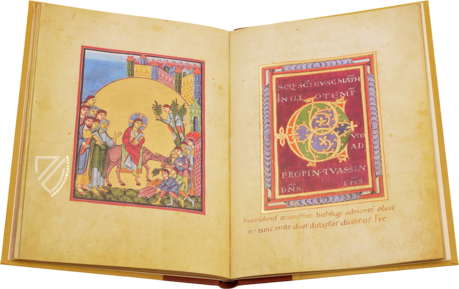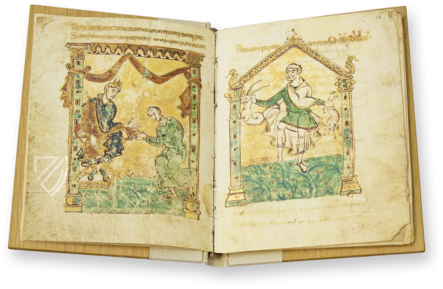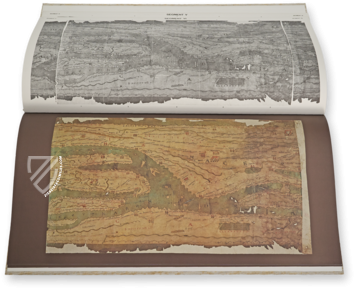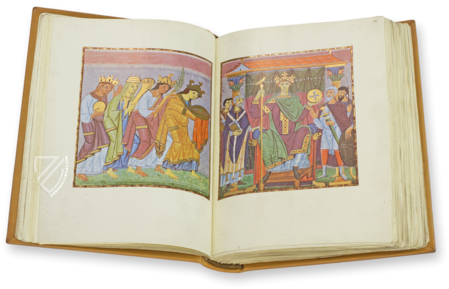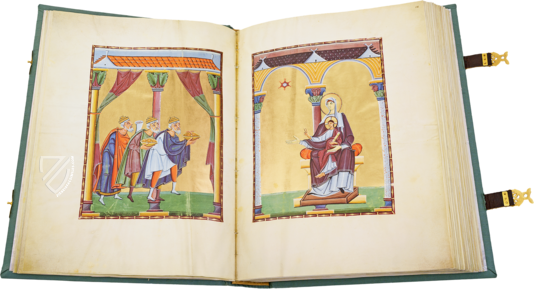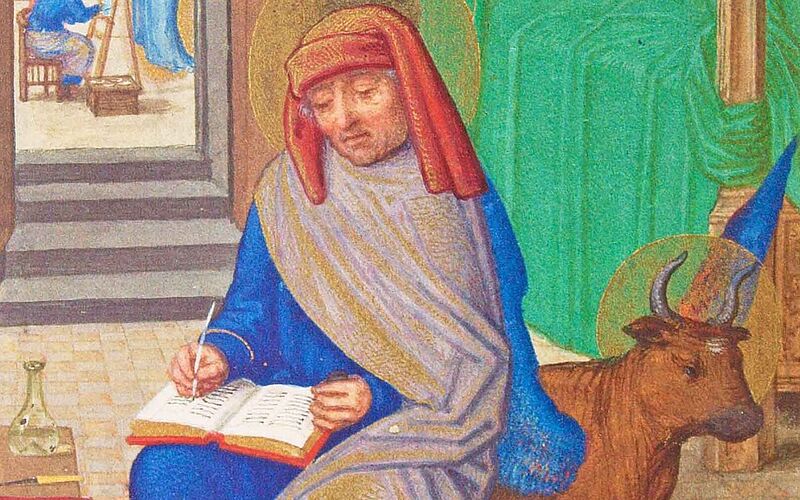Reichenau Gospel Lectionary
(1,000€ - 3,000€)
Situated at Lake Constance, at the foot of the Alps, Reichenau Abbey's scriptorium was responsible for some of the greatest illuminated manuscripts in all of European history and was preeminent among European scriptoria ca. 1000. During the Ottonian age, splendid Reichenau manuscripts were created for high ranking clientele such as Otto III, Henry II, or Egbert, the Archbishop of Trier. The Gospel Lectionary of Reichenau is an unfinished illuminated manuscript that appears to have been intended for an important patron or as a gift because its dedication page features an enthroned monarch. This manuscript is significant for research into the development of the Reichenau school because it originated during a period of transition, thus combining typical Ottonian artistry with new innovations. This manuscript represents a key piece of evidence for art historical researchers as well as a fascinating work of art for lovers of illuminated manuscripts.
Gospel Lectionary of Reichenau
The Gospel Lectionary of Reichenau was made over 900 years ago in the scriptorium of Reichenau Abbey, then the most important painting school of the West, and is considered to be the key work for the evaluation of Reichenau book painting. All 182 pages (91 folios) of this Gospel Lectionary present the central lessons of the history of Salvation to the reader. The miniatures, inserted sometimes as full pages, sometimes as strips, are lavishly embellished with gold and still entirely in the tradition of Ottonian art. It is these miniatures that enchant the reader with the delicate charm so characteristic of the Reichenau school. The fixed order of the pictorial arrangements, a heritage of Ottonian art, unexpectedly combines with an expressive figurative style to overcome the statuary stiffness, long before Romanesque tradition saw the light of day. Wide swinging gestures lend a strong momentum to the pictures and the enhancement of mimic expression provides the Biblical narrative with emotion and vividness. The close juxtaposition of different style elements makes the Gospel Lectionary of Reichenau a product, typical of a transitionary phase that is clearly marked by both traditional elements and a new beginning, thus forming a truly unique synthesis, in an unmatched combination.
A Book of Liturgy
The text of the Gospel Lectionary is written in Carolingian minuscule and ornamented with a great wealth of luxurious initials. It starts with one of the four prefaces to the Gospel Book, the third preface of Hieronymus, which is followed by the four prologues introducing the individual Gospels. The Gospel Pericopes start with the lecture In vigilia nativitate domini and continue with lectures of the ecclesiastical year, from Christmas to Easter and the 26th Sunday after Pentecost, to end with the four Sundays of Advent, the feast days of the saints and a series of votive masses.
A Precious Gift for a Sovereign
The overall character of the manuscript is that of an unfinished work. Some pictures are missing and the miniature of the birth of St. John the Baptist remained unfinished. This is all the more surprising as it was conceived as a gift for a high-ranking personality, judging from the donor’s portrait. The dedication picture shows a crowned sovereign, in his left hand an orb with an eagle. A monk to his left hands him a book, no doubt the Gospel Lectionary of Reichenau. Very little is known concerning the identity of the sovereign depicted in this dedication picture. Besides Henry IV, Henry III was mentioned time and again as receiver of the manuscript. Perhaps the sovereign on the one hand and the unfinished state of the codex on the other can be explained by their common historic background: the manuscript might have remained unfinished as the occasion of its donation was no longer valid.
A Unique Manuscript
Although a number of questions are left unanswered, this manuscript is a typical example for a transition phase. Its expressive movements and vivid illustration of the Biblical narrative show a variation of the Ottonian canon of forms. Imperial traditions combine with an effort for purity in both script and liturgy.
Codicology
- Alternative Titles
- Reichenau Evangelistary
Das Reichenauer Evangelistar
Berlin Gospel Lectionary - Size / Format
- 182 pages / 28.0 × 21.0 cm
- Origin
- Germany
- Date
- 2nd half of the 11th century
- Epochs
- Style
- Language
- Script
- Carolingian minuscule Rustic and square capitals
- Illustrations
- 29 full-page miniatures with rich gold ornaments, partly divided into several registers (stripes); 6 incipit pages and numerous gold initials
- Content
- Evangelistary
Reichenau Gospel Lectionary
Adoration of the Magi
Stylistically uniform, the miniatures of this manuscript are characterized by individualized depictions of the figures with emphasized gestures. The Three Kings are a good example of this: one is a young man with a red beard, another has a black beard that is going grey, and the third has a white beard. All the figures have elongated fingers from the Baby Jesus making the sign of benediction, to the Magi presenting gifts, to the Virgin Mary extending her hand to receive them. Unlike the rest of the figures, who have pink complexions, Mary is pale white.
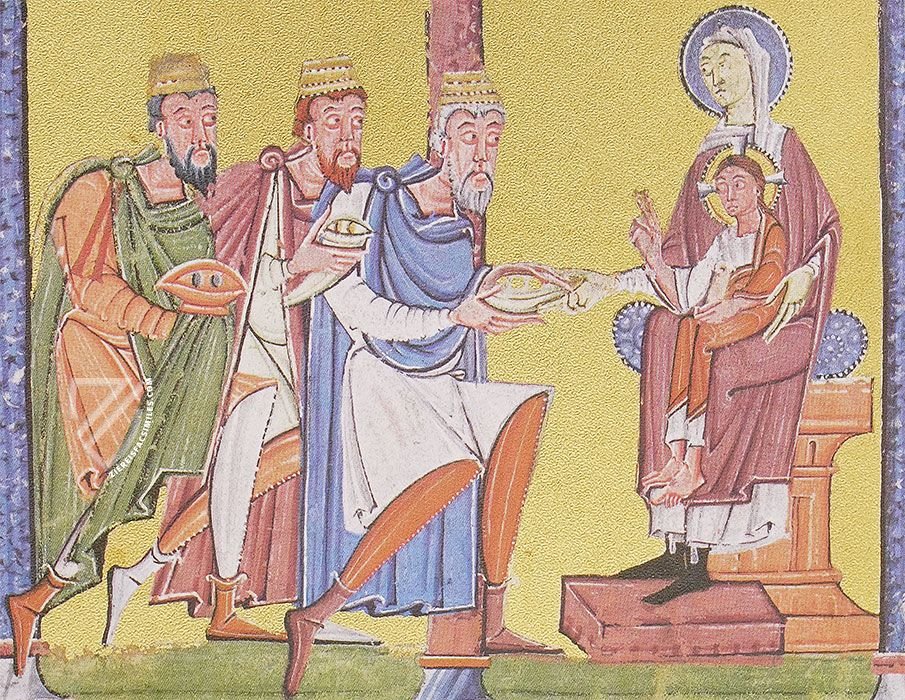
Reichenau Gospel Lectionary
Dedication Portrait of…Whom?
This is a perfect example of a late-Ottonian miniature of an enthroned and crowned monarch, holding a globe with an imperial eagle in this case, being presented with a codex. However, the identity of the figure remains unknown and is tied to the debate over whether the manuscript was created in the 1050’s or the 1070’s as a commission of either Emperor Henry III or Henry IV.
Aside from the artistic balance between the Ottonian tradition and new Romanesque innovations, those arguing for an earlier date point to the incomplete state of the manuscript, including this image: unlike the face of the scribe presenting the codex, both the face of the emperor and of his arm bearer are unfinished sketches. This points to Henry III, who died in 1056, which would explain why the manuscript was never completed, but this still open to debate.
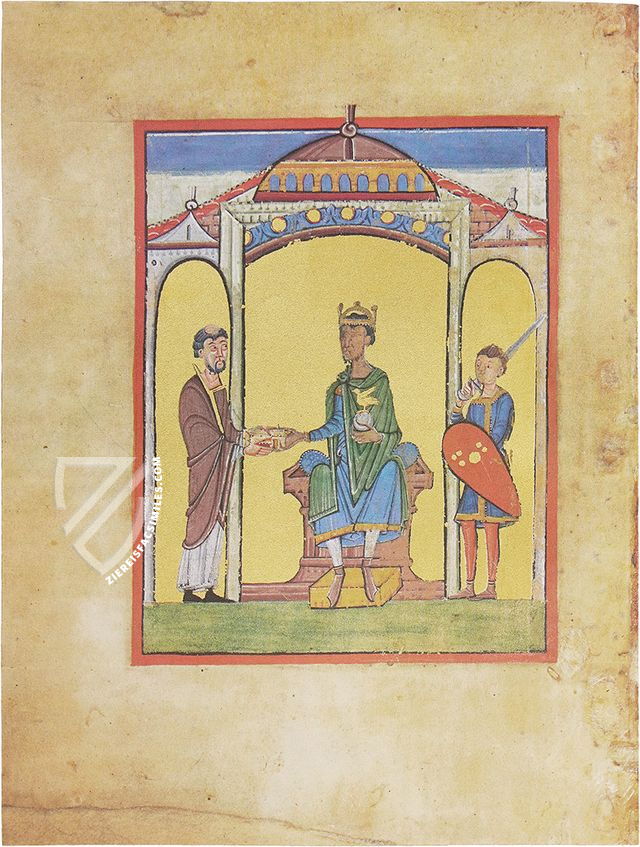
#1 Das Reichenauer Evangelistar
Language: German
(1,000€ - 3,000€)
- Treatises / Secular Books
- Apocalypses / Beatus
- Astronomy / Astrology
- Bestiaries
- Bibles / Gospels
- Chronicles / History / Law
- Geography / Maps
- Saints' Lives
- Islam / Oriental
- Judaism / Hebrew
- Single Leaf Collections
- Leonardo da Vinci
- Literature / Poetry
- Liturgical Manuscripts
- Medicine / Botany / Alchemy
- Music
- Mythology / Prophecies
- Psalters
- Other Religious Books
- Games / Hunting
- Private Devotion Books
- Other Genres
- Afghanistan
- Armenia
- Austria
- Belgium
- Belize
- Bosnia and Herzegovina
- China
- Colombia
- Costa Rica
- Croatia
- Cyprus
- Czech Republic
- Denmark
- Egypt
- El Salvador
- Ethiopia
- France
- Germany
- Greece
- Guatemala
- Honduras
- Hungary
- India
- Iran
- Iraq
- Israel
- Italy
- Japan
- Jordan
- Kazakhstan
- Kyrgyzstan
- Lebanon
- Liechtenstein
- Luxembourg
- Mexico
- Morocco
- Netherlands
- Palestine
- Panama
- Peru
- Poland
- Portugal
- Romania
- Russia
- Serbia
- Spain
- Sri Lanka
- Sweden
- Switzerland
- Syria
- Tajikistan
- Turkey
- Turkmenistan
- Ukraine
- United Kingdom
- United States
- Uzbekistan
- Vatican City
- A. Oosthoek, van Holkema & Warendorf
- Aboca Museum
- Ajuntament de Valencia
- Akademie Verlag
- Akademische Druck- u. Verlagsanstalt (ADEVA)
- Aldo Ausilio Editore - Bottega d’Erasmo
- Alecto Historical Editions
- Alkuin Verlag
- Almqvist & Wiksell
- Amilcare Pizzi
- Andreas & Andreas Verlagsbuchhandlung
- Archa 90
- Archiv Verlag
- Archivi Edizioni
- Arnold Verlag
- ARS
- Ars Magna
- ArtCodex
- AyN Ediciones
- Azimuth Editions
- Badenia Verlag
- Bärenreiter-Verlag
- Belser Verlag
- Belser Verlag / WK Wertkontor
- Benziger Verlag
- Bernardinum Wydawnictwo
- BiblioGemma
- Biblioteca Apostolica Vaticana (Vaticanstadt, Vaticanstadt)
- Bibliotheca Palatina Faksimile Verlag
- Bibliotheca Rara
- Boydell & Brewer
- Bramante Edizioni
- Bredius Genootschap
- Brepols Publishers
- British Library
- C. Weckesser
- Caixa Catalunya
- Canesi
- CAPSA, Ars Scriptoria
- Caratzas Brothers, Publishers
- Carus Verlag
- Casamassima Libri
- Centrum Cartographie Verlag GmbH
- Chavane Verlag
- Christian Brandstätter Verlag
- Circulo Cientifico
- Club Bibliófilo Versol
- Club du Livre
- CM Editores
- Collegium Graphicum
- Collezione Apocrifa Da Vinci
- Comissão Nacional para as Comemorações dos Descobrimentos Portugueses
- Coron Verlag
- Corvina
- CTHS
- D. S. Brewer
- Damon
- De Agostini/UTET
- De Nederlandsche Boekhandel
- De Schutter
- Deuschle & Stemmle
- Deutscher Verlag für Kunstwissenschaft
- DIAMM
- Droz
- E. Schreiber Graphische Kunstanstalten
- Ediciones Boreal
- Ediciones Grial
- Ediclube
- Edições Inapa
- Edilan
- Editalia
- Edition Deuschle
- Edition Georg Popp
- Edition Leipzig
- Edition Libri Illustri
- Editiones Reales Sitios S. L.
- Éditions de l'Oiseau Lyre
- Editions Medicina Rara
- Editorial Casariego
- Editorial Mintzoa
- Editrice Antenore
- Editrice Velar
- Edizioni Edison
- Egeria, S.L.
- Eikon Editores
- Electa
- Emery Walker Limited
- Enciclopèdia Catalana
- Eos-Verlag
- Ephesus Publishing
- Ernst Battenberg
- Eugrammia Press
- Extraordinary Editions
- Fackelverlag
- Facsimila Art & Edition
- Facsimile Editions Ltd.
- Facsimilia Art & Edition Ebert KG
- Faksimile Verlag
- Feuermann Verlag
- Folger Shakespeare Library
- Franco Cosimo Panini Editore
- Friedrich Wittig Verlag
- Fundación Hullera Vasco-Leonesa
- G. Braziller
- Gabriele Mazzotta Editore
- Gebr. Mann Verlag
- Gesellschaft für graphische Industrie
- Getty Research Institute
- Giovanni Domenico de Rossi
- Giunti Editore
- Graffiti
- Grafica European Center of Fine Arts
- Guido Pressler
- Guillermo Blazquez
- Gustav Kiepenheuer
- H. N. Abrams
- Harrassowitz
- Harvard University Press
- Helikon
- Hendrickson Publishers
- Henning Oppermann
- Herder Verlag
- Hes & De Graaf Publishers
- Hoepli
- Holbein-Verlag
- Houghton Library
- Hugo Schmidt Verlag
- Idion Verlag
- Il Bulino, edizioni d'arte
- ILte
- Imago
- Insel Verlag
- Insel-Verlag Anton Kippenberger
- Instituto de Estudios Altoaragoneses
- Instituto Nacional de Antropología e Historia
- Introligatornia Budnik Jerzy
- Istituto dell'Enciclopedia Italiana - Treccani
- Istituto Ellenico di Studi Bizantini e Postbizantini
- Istituto Geografico De Agostini
- Istituto Poligrafico e Zecca dello Stato
- Italarte Art Establishments
- Jan Thorbecke Verlag
- Johnson Reprint Corporation
- Josef Stocker
- Josef Stocker-Schmid
- Jugoslavija
- Karl W. Hiersemann
- Kasper Straube
- Kaydeda Ediciones
- Kindler Verlag / Coron Verlag
- Kodansha International Ltd.
- Konrad Kölbl Verlag
- Kurt Wolff Verlag
- La Liberia dello Stato
- La Linea Editrice
- La Meta Editore
- Lambert Schneider
- Landeskreditbank Baden-Württemberg
- Leo S. Olschki
- Les Incunables
- Liber Artis
- Library of Congress
- Libreria Musicale Italiana
- Lichtdruck
- Lito Immagine Editore
- Lumen Artis
- Lund Humphries
- M. Moleiro Editor
- Maison des Sciences de l'homme et de la société de Poitiers
- Manuscriptum
- Martinus Nijhoff
- Maruzen-Yushodo Co. Ltd.
- MASA
- Massada Publishers
- McGraw-Hill
- Metropolitan Museum of Art
- Militos
- Millennium Liber
- Müller & Schindler
- Nahar - Stavit
- Nahar and Steimatzky
- National Library of Wales
- Neri Pozza
- Nova Charta
- Oceanum Verlag
- Odeon
- Orbis Mediaevalis
- Orbis Pictus
- Österreichische Staatsdruckerei
- Oxford University Press
- Pageant Books
- Parzellers Buchverlag
- Patrimonio Ediciones
- Pattloch Verlag
- PIAF
- Pieper Verlag
- Plon-Nourrit et cie
- Poligrafiche Bolis
- Presses Universitaires de Strasbourg
- Prestel Verlag
- Princeton University Press
- Prisma Verlag
- Priuli & Verlucca, editori
- Pro Sport Verlag
- Propyläen Verlag
- Pytheas Books
- Quaternio Verlag Luzern
- Reales Sitios
- Recht-Verlag
- Reichert Verlag
- Reichsdruckerei
- Reprint Verlag
- Riehn & Reusch
- Roberto Vattori Editore
- Rosenkilde and Bagger
- Roxburghe Club
- Salerno Editrice
- Saltellus Press
- Sandoz
- Sarajevo Svjetlost
- Schöck ArtPrint Kft.
- Schulsinger Brothers
- Scolar Press
- Scrinium
- Scripta Maneant
- Scriptorium
- Shazar
- Siloé, arte y bibliofilia
- SISMEL - Edizioni del Galluzzo
- Sociedad Mexicana de Antropología
- Société des Bibliophiles & Iconophiles de Belgique
- Soncin Publishing
- Sorli Ediciones
- Stainer and Bell
- Studer
- Styria Verlag
- Sumptibus Pragopress
- Szegedi Tudomànyegyetem
- Taberna Libraria
- Tarshish Books
- Taschen
- Tempus Libri
- Testimonio Compañía Editorial
- Thames and Hudson
- The Clear Vue Publishing Partnership Limited
- The Facsimile Codex
- The Folio Society
- The Marquess of Normanby
- The Richard III and Yorkist History Trust
- Tip.Le.Co
- TouchArt
- TREC Publishing House
- TRI Publishing Co.
- Trident Editore
- Tuliba Collection
- Typis Regiae Officinae Polygraphicae
- Union Verlag Berlin
- Universidad de Granada
- University of California Press
- University of Chicago Press
- Urs Graf
- Vallecchi
- Van Wijnen
- VCH, Acta Humaniora
- VDI Verlag
- VEB Deutscher Verlag für Musik
- Verlag Anton Pustet / Andreas Verlag
- Verlag Bibliophile Drucke Josef Stocker
- Verlag der Münchner Drucke
- Verlag für Regionalgeschichte
- Verlag Styria
- Vicent Garcia Editores
- W. Turnowski Ltd.
- W. Turnowsky
- Waanders Printers
- Wiener Mechitharisten-Congregation (Wien, Österreich)
- Wissenschaftliche Buchgesellschaft
- Wissenschaftliche Verlagsgesellschaft
- Wydawnictwo Dolnoslaskie
- Xuntanza Editorial
- Zakład Narodowy
- Zollikofer AG

